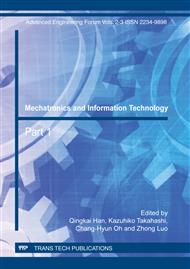p.200
p.205
p.211
p.219
p.223
p.228
p.234
p.239
p.243
A Signature Identification Method Based on Strength and Strokes Direction
Abstract:
It was much more complex and difficult for off-line signature identification attributable to the limitation of available information. To solve the problem, a signature identification method based on strength and strokes direction was proposed. The signature image acquired was gray-scaled and filtered at the stage of preprocess; then the image was two-valued with different threshold based on strength feature, the regions which grayscale was less than threshold were retained; the strokes which possess distinctive directional feature were extracted by using mathematical morphology and combining different scales/directions structure element based on strokes direction feature; at last judgement was maked for sample in accordance with corresponding feature. Experimental results showed the proposed method can enhance accurate rate effectively, improve real-time performance, which was a try beneficial to apply new methods for off-line signature identification.
Info:
Periodical:
Pages:
223-227
Citation:
Online since:
December 2011
Authors:
Permissions:
Share:
Citation:


